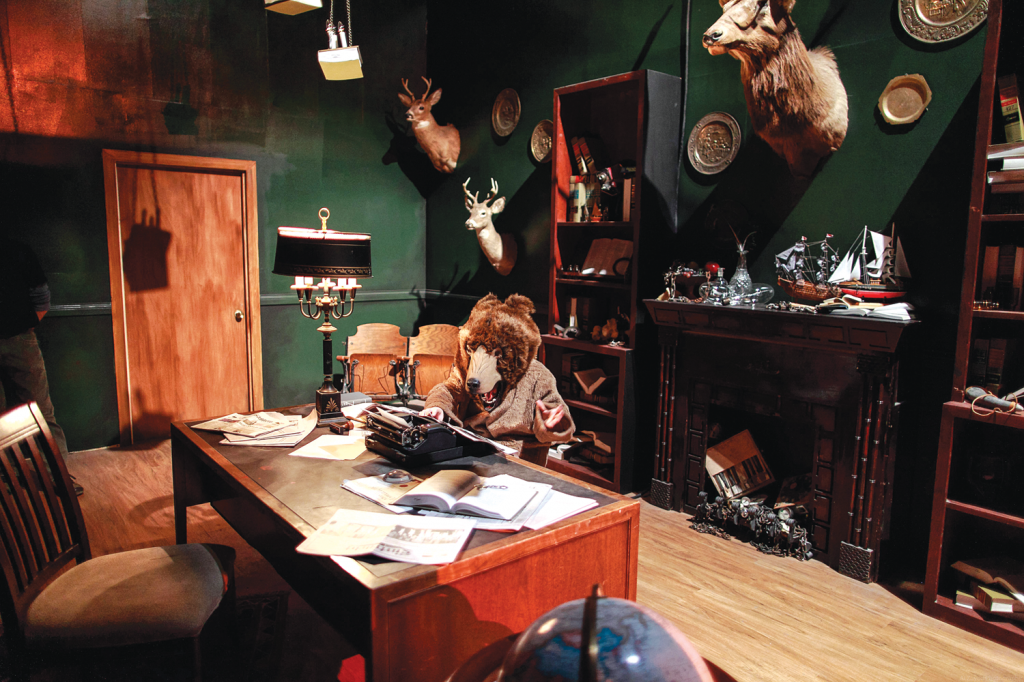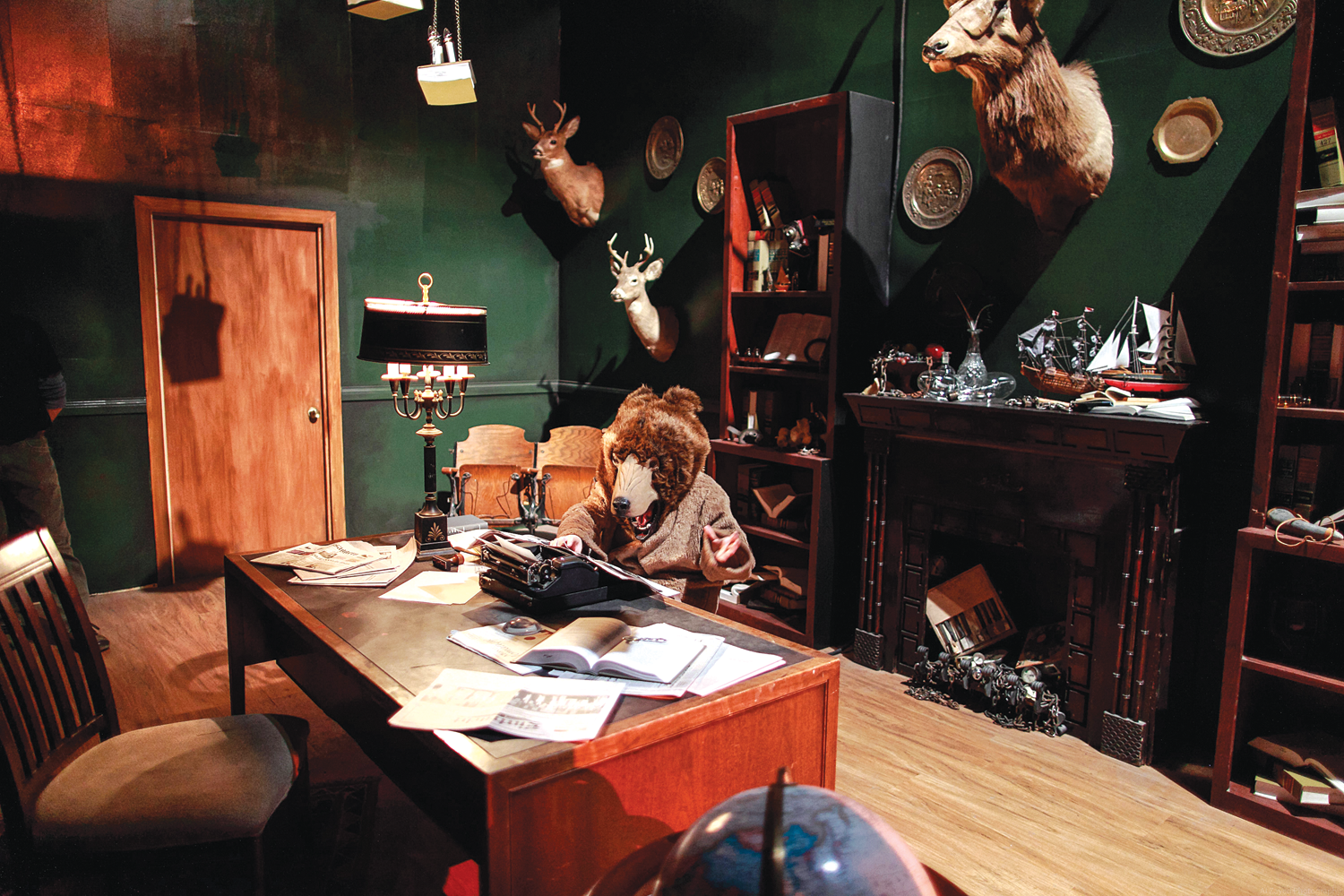
When I first arrived at Redmoon Theater’s enormous warehouse for a preview of their new show (or, as they call it, their new “spectacle”), director Blake Montgomery confessed he was “a little nervous” about my walking through the two-story, dozen-room set. This set, which viewers have the privilege of exploring at their leisure over the course of a night, is what makes Bellboys, Bears, and Baggage “like no other,” according to associate producer Will Bishop. When I arrived Bishop warned me that parts of the show’s world were in “various states of completion.” Nevertheless, he agreed to take me on a tour, with the lights on, through Redmoon’s “environmental exploration” of love, loss, and bitter Shakespearian regret.
The moment we entered the enormous central room, a record player turned on, apparently of its own volition, and started playing a haunting strain of music. As a technician came over and turned it off, Bishop explained to me the central premise of the show: the audience can drift from room to room in the warehouse, but will always follow a central story (derived from Shakespeare’s The Winter’s Tale) that concerns two masked characters and their troubled romance. Bishop cautioned, however, that there was no single way to witness this story.
“I don’t think there is such a thing as misunderstanding [the show],” said Bishop. “We start our devising process from large thematic ideas, like abandonment, loss, and regret. And I think there’s going to be enough going on that you’ll get that… But beyond that, we don’t want to tell you what to feel about those ideas, or even what the story is.”
We made our way through the warehouse’s various rooms: a forest (more or less finished), a schoolroom (half-finished), and a chapel (utterly unfinished). In each of these rooms, explained Bishop, there was to be a scene that viewers could choose to watch or not watch.
“The audience can follow characters and track the story, or just explore,” said Bishop. “There are all sorts of interactive opportunities for people to come in and have an experience that isn’t story-based at all.” He showed me a small alcove at the end of a long maze on the second floor where, if one were feeling bold or romantic, one could sit down with a fellow viewer and open up a bottle of wine. As we wandered through the maze, Bishop pointed out a fridge that would soon hide ice cream and drawers full of jellybeans which would lie in wait for curious audience members. These details, which Bishop claimed made Bellboys, Bears, and Baggage an immersive and open universe—ice cream hidden in refrigerators, notes hidden in drawers—were, as of my preview, nonexistent.
Bishop and Montgomery, however, seemed confident that the show would pull itself up by its bootstraps by the time I saw it a week and a half later. Excitedly, Bishop finished the tour by telling me about the rogue bears (inspired by The Winter’s Tale’s famous stage direction, “Exit, pursued by a bear”) that were going to run around the set and wreak havoc on both actors and audience members.
“We just want to present to you an opportunity to reflect in the context of a larger experience that you create,” he explained. “[We tried to figure out] how to do an indoor show that challenges audiences to become empowered and make choices in the way our outdoor work does.”
The freedom that Bellboys, Bears, and Baggage gives its audience was, ultimately, the element that managed to hold the whole thing together. When I entered the central atrium one week later for the opening night performance, I found it vastly changed. A dozen record players blasted tunes ranging from the symphonic to the cacophonous; giant screens displaying bear paws hung from the ceiling; William Shakespeare scattered flower petals from a tower in the center of the room; bellboys milled about picking up luggage and depositing it in the hands of unsuspecting audience members. The audience is thrown into this madhouse with hardly the slightest indication of where to go.
Even once one chooses from the dozen-odd rooms and tries to peer in on a scene, Bellboysproves hard to grasp. One is just as likely to stumble into an empty room as a room with a scene unfolding within it. There is no available chronology, and, except for one room (wherein an actress either recites Shakespeare soliloquies or sobs madly), the masked actors and actresses playing the main couple do not utter a single line. Even if one follows a particular pair of actors through the rooms (all of which had been adorned with exceptional decorations, like hanging chairs, taxidermied moose bearing the names of famous Shakespeare characters, and random bottles of drinkable wine), it’s almost impossible to tell what is going on in the main story; had Bishop not informed of its existence, I would have been hard-pressed to admit that there even was a story.
However, as one spends more time in the show’s universe (and it is a universe, bizarre and full of surprises) its secrets and intricacies become more available. A machine with many, many moving parts, Bellboys often encourages and rewards attempts to break the fifth wall between actors and audience: bellboys will often impart secrets about a scene’s meaning if asked, and sometimes drawers and tables contain notes that flesh out the action of other rooms’ scenes. If you knock on a door labeled “DO NOT DISTURB,” a bear opens the door and motions for you to go away. Inspecting labels on walls and baggage exposes one to keywords that color the otherwise opaque scenes with thematic meaning: “loss;” “to err is human;” “regret;” “time heals all wounds.”
Indeed, for Bellboys, time does heal all wounds, or at least makes some things clearer: if one hangs around and revisits particular rooms, the patterns of misfortune that the show’s lead couple face become visible. The minutiae encountered in one room compel one to revisit another. But when one does, one is met only with a corrupted version of a scene already played out: perhaps there are two male characters instead of just one, or perhaps a woman in a bed has been replaced by a polar bear. It’s possible for one to leave Redmoon feeling like one has no more idea what is going on than one did when one entered, but that’s part of the show’s cultivated chaos. That’s why there are bears running around chasing characters into rooms, and why there are pianos and jellybeans scattered throughout the space: in Bellboys, the audience does not receive the story—they create it.
Redmoon Theater, 2120 S. Jefferson St. Through June 8. Thursday, 7pm-9pm; Friday-Saturday



